Tashara knew something was wrong.
 The 32-year-old high school teacher was experiencing heavy periods, wearing super tampons all of the time. Her friends and family reassured her and said: “Oh, you are just getting older; it’s no big deal. Let it go.”
The 32-year-old high school teacher was experiencing heavy periods, wearing super tampons all of the time. Her friends and family reassured her and said: “Oh, you are just getting older; it’s no big deal. Let it go.”
She scheduled a well woman’s exam anyway, and was told that she had an enlarged uterus, but it was probably just a fibroid and nothing to worry about. Not long after, Tashara said she began making frequent bathroom trips and thought she might have a UTI. “I would wake up to go, and five minutes later, to go again.”
Something was pressing on her bladder. It turned out that it was an 8 cm fibroid, the size of an orange.
Avoiding a hysterectomy for fibroids
“I was referred to a gynecologist, but she didn’t specialize in fertility,” said Tashara
(A board certified reproductive endocrinologist has completed additional years of fellowship training to become a fertility specialist.)
The physician gave Tashara options to remove the fibroid, but told her there is always the chance that, in removing the fibroid, a non-cancerous growth of muscle cells and connective tissue, she would also remove the uterus during a hysterectomy—the most common women’s surgery after c-sections.
“I’m fairly young, don’t have kids yet and knew for sure I didn’t want to have my fertility disrupted, and so I sought out a second opinion with a fertility specialist.”
She looked online for fertility centers in Austin and went to Yelp.
“Texas Fertility Center popped up and all of the physicians at Texas Fertility Center had pretty good reviews so I gave them a call.”
Dr. Lisa Hansard was “confident and reassuring”
Tashara saw Dr. Lisa Hansard in August, when school was about to start.
“She gave me an ultrasound and said: ‘You have a fibroid, you want to have children and so here is your option—a mini-laparotomy myomectomy.’” She reassured Tashara that it was completely normal to have fibroids, and to have fibroids of this size.
As a current graduate student and full-time teacher, the young woman was comfortable with online research. She came to Dr. Hansard with prepared questions about the uterine condition, her family history of hysterectomy and what to expect with fertility surgery.
“This was my first surgery so I wanted to make sure I had all of the facts,” she said. “Dr. Hansard explained everything that was going to happen, and it proceeded exactly as she said it would. That took away a lot of anxiety.”
An excerpt from Tashara’s online review included this detail about her fibroid surgery: “Dr. Hansard came in and we chatted for a second, then I was taken back to the operating room. The last thing I remember was Dr. Hansard holding my hand on the table. Such an awesome thing to do considering she knew how nervous I was.”
Minimally invasive fibroid surgery fast-tracked Tashara’s recovery time
Tashara expected six weeks of recovery, and as a teacher that was not going to be possible. She couldn’t take that much time off.
“Dr. Hansard said it would not be six weeks and that I would bounce back. Literally, to the day, two weeks after fibroid surgery, I went to grad school class. Four weeks later I was back at Camp Gladiator.”
She says fibroid surgery has been the best thing ever. “I had a period this month and didn’t have to use a single super tampon!”
Although Tashara is not currently trying to get pregnant, she has friends who are struggling with infertility. She recommended Dr. Hansard to a friend and teacher who is trying to get pregnant.
“This was probably the best experience I’ve had with a doctor.”
If you have experienced symptoms of fibroids and plan to have children one day, contact Texas Fertility Center. A highly skilled reproductive surgeon uses minimally invasive techniques to resolve gynecologic issues while preserving fertility.














Comments are closed.